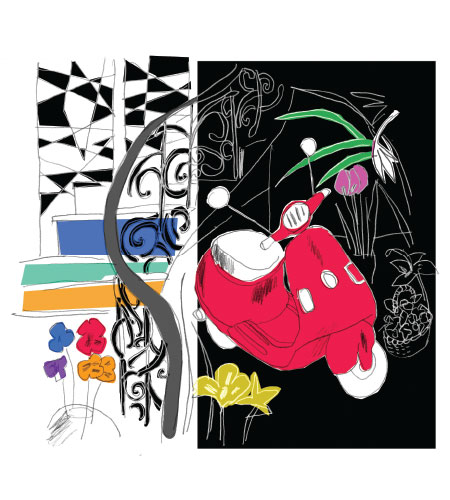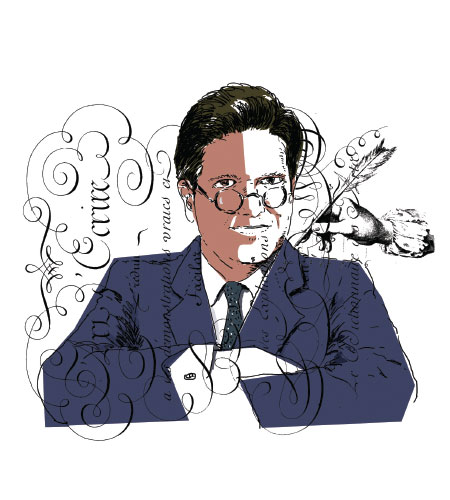
The recycled fashion shop in Rome by Livia Firth
RE(f)USE , 40 Via della Fontanella di Borghese, carminacampus.com
I always enjoy wandering along the magical street of Via della Fontanella di Borghese, in the historical heart of Rome. Not just for its history and culture. I go primarily to see Ilaria Venturini Fendi’s magical shop, RE(f)USE. Ilaria launched her ethical fashion brand Carmina Campus a few years ago because she wanted to make her business more sustainable and to find a way of extending the life of objects.
It is the only store I know of whose fashion and design objects are all made exclusively with recycled materials. They use all sorts of things – remnants from factories, discarded fabric, end-of-line stock, vintage snippets – which are then all assembled and reused to create something with a totally new shape and function. When you enter RE(f)USE, you feel like Alice in Wonderland: the selections of jewelry, accessories, tables, chairs, sofas, lamps, chandeliers and other pieces of design are all unique. There are all sorts of incredible works by some of the most unconventional designers from all over the world, including the Berlin-based Stuart Haygarth and the Belgian Charles Kaisin.
The first floor is the place that reflects Ilaria’s real passion. It’s all paneled with mirrors and stocked with dozens of handbags, each of them different styles, sizes and colours and upcycled by artisans from Italy and Africa. What makes them extra-special is that each piece carries a tag, telling its story, listing the materials that have been used to make it and the number of hours spent to produce it by hand. To me, this place is temple of design. It’s somewhere I love going into and never regret buying anything from.
Your address: The St. Regis Rome
The California chocolatier by Sally Perrin
Christopher Michael Chocolatier, 2346 Newport Blvd, Costa Mesa, chrischocolates.com
This is really a hidden gem, because it’s in an unassuming shopping center on the Newport Peninsula where you’d never expect to find something quite as incredible. It is total chocolate heaven. To the right, as you walk in, there’s a counter featuring all the truffles, ganaches and confections of the day, and to the left, ready-made packages which make easy-to-grab gifts, including the store’s famous chocolate bars with unique flavors.
The chef-owner, Christopher Michael Wood, discovered a chocolatier in SoHo in New York, and in 2006 decided to try to bring the same level of craft and detail to his native California. Every time I go to the Dana Point area, I have to go and get something: a bar, truffles, bonbons, chocolate-covered nuts... current favorites are his balsamic-caramel and chocolate-covered strawberries, his unusual bars, like the spicy pomegranate and lime and his lavender-infused caramels. My husband absolutely loves the Sizzling Bacon Bar, which is Venezuelan chocolate flavored with sea salt, smoked bacon and popping candy.
What’s great is that they take classics and twist them; they take a risk, which is what I like to do. I like the unusual, the untried, the unexpected. And I like the fact that it’s small and artisanal. Christopher takes care of every little detail, whether that’s the painstaking airbrushing of designs on his chocolates or the unique flavors he creates on the premises. I am not sure whether to thank the friend who brought a box to a dinner party we had at our home a few years ago. I had three pieces and have been hooked ever since!


The homewares store in Mexico City by Kiyan Foroughi
Common People, Emilio Castelar 149, Colonia Polanco, commonpeople.com.mx
This store, in a beautiful four-story 1940s colonial mansion, is on an upmarket street in the characterful area of Polanco, which is known for its architecture, restaurants and hotels. From the outside there is no hint of what is within and even when you step through the door, it seems more like a gallery than a store. Nothing’s straightforward-looking. All the merchandise looks as though it’s been caught on a strong breeze: there are bags, plates, cushions of all sorts, piled high and hanging from walls and roofs.
The idea of the owners, Monika Biringer and Max Feldman, was to create “a place filled with uncommon things for common people.” And that’s what it is. There’s something to contemplate wherever you look and nothing is the same. There are all sorts of names, from independent local artists to international figures. So you’ll get local companies such as TOSCA, which produces big, chunky jewelry, alongside Commes des Garçons and Vivienne Westwood, clothing piled alongside homewares, and high-tech gadgets next to projects by artists and musicians. It’s a bit like Colette in Paris. One minute you’ll be looking at books from Assouline, the next furniture from Vitra and then vintage pieces from the forager Emmanuel Picault.
The owners are involved in the creative scene in the area – fashion, design, art, music, everything – and incorporate that into the store wherever possible, which gives it a lovely creative edge. What’s great, too, is that although the assistants are incredibly cool, they’re not at all snobby and will know all about the makers: who they are, where they’re from and how they’ve made things. So every time you go in, you learn. A friend who recommended it to me suggested that I didn’t go in if I was in a hurry, and he was right. If you’re not shopping, then there’s a café and a beautiful ornate staircase to go up, to discover a whole other floor, then another, then another…
Your address: The St. Regis Mexico City
The haberdasher in New York by Collette Dinnigan
Tinsel Trading Company, 828 Lexington Avenue, tinseltrading.com
This shop is so tiny that it would be easy to miss. Its previous address, on West 38th Street in the Garment District, was even smaller. But wherever its location, it has always been packed from ceiling to floor with treasures. Four generations of the same family have worked in the business since the current owner’s grandfather, Arch J. Bergoffen, took it on in 1933, specialising in French tinsel and metal threads, and it has much of the same charm, if not as much clutter or dust, as the original.
It’s the ultimate shop for treasure seekers: full of shiny, beautiful ornamentation that has been collected by its owners for decades, from all over the world. There are antique trims and beading from the 1930s and 1940s, metal fringing, tassels, vintage cards from 1900, old labels, waxed flowers. The things I most love are the buttons. In the old shop, you had to go through hundreds of boxes and jars to find the ones that were really special: those that were hand-painted, glass, covered in silk and velvet, collected from old military jackets. Sometimes they might only have enough for ten dresses; other times for whole collections.
Now the shop is much more organized. The buttons are all in boxes with a button sewn on to the front, so you know what’s inside. The rolls of fabric are also now merchandised according to colour, with a flower at the end of each roll, so the whole wall looks like a spring field.
What’s great fun is that you never know what you might find. Once I came out with a collection of big letters from the 1930s covered with real, old-fashioned glass glitter. Another time I found beautiful old tags and some quaint pieces of original embroidery and lace.
Today, it has been brought much more up-to-date; they now even have a website, which is handy if you can’t get there in person. Also, if you let them know what you want, they can often help you find it from one of their many contacts all over the world. It’s one of those quirky, quite peculiar places that is a real one-off. Just talking about it makes me long to go and rummage around in it.
Your address: The St. Regis New York


The sushi bar in Osaka by Maria McElroy
Yamane, 1-3-1 Doujima Kitaku (+81 6 6348 1460)
The exclusive Kitashinchi neighborhood is the beating heart of Osaka at night, and this sushi restaurant is right in the center of it. Above the narrow streets are a tangle of neon signs and boards inviting people inside, to secret little places where geishas once delighted customers. Because the area has such a lovely feeling, it’s where the cream of Osaka society goes. There are half a dozen Michelin-starred restaurants around, but for me and my Kyoto-born husband, Yamane is by far the best.
You’d never know from the outside that it was so special. It’s in an unassuming building and behind the sliding door is an intimate space, with a delicate blond-wood latticed sushi bar, behind which the master sushi chef Mr Yamane and his staff work.
There is nothing quite like sitting there, watching the action. Like most old traditional establishments, the fish from that morning’s catch at Sakai fish market is not on display, but kept in boxes of ice and taken out when the chefs need to slice it with their precision knives. Some of them have been sushi chefs for decades and are masters in local specialities: mehari, a heady combination of rice with fatty tuna and salmon caviar wrapped in pickled mustard or square hakozushi, topped with marinated mackerel and kelp. Although I always have their tuna, octopus and flounder sushi, I love their dashimaki tamago, a thick, warm rolled omelet, much softer and more pliable than those you find in Tokyo.
The food, as you’d expect from someone with such a precise eye, is presented in an extremely elegant way, on ceramic plates made by the famous ceramicist Ippento Nakagawa. And the smells that waft through the air, of warm soy sauce, incense and the freshness of the sea, are as enjoyable as the sounds of the chefs chatting and laughing. The people in this area of Japan are known to be very funny and full of life, and although everyone is hugely respectful of Mr Yamane, his restaurant is full of warmth and humor.
Your address: The St. Regis Osaka
The stationery shop in Washington, D.C. by Fareed Zakaria
Thornwillow, The St. Regis D.C., 923 16th Street, thornwillow.com
Entering Thornwillow is like entering a library or a gentleman’s club. It even has a “librarian” to look after you, who encourages you to have a cup of tea or a whiskey while you sit and browse books. It’s an extraordinary publishing house: a place where you can buy books, or get them printed, and walk out with incredibly beautiful stationery. My wife and I had our New Year cards printed there and as usual, the owner, Luke Ives Pontifell, came up with a wonderfully whimsical design: a flying pig!
He is one of those people who is extraordinarily wise although still pretty young. He wears wire-rimmed glasses and three-piece suits with a pocket square so you feel a bit like you’re talking to someone from another era.
We’ve also visited the place in which the books are made, an old coat factory in Newburgh, New York. There, we realized what a craft bookmaking is: they have lots of men, I think from Eastern Europe, who obviously make each book as a labor of love. They are expensive, but each one is fashioned by hand, their handmade paper covered in beautiful leather and each special for a different reason, whether it’s President Obama’s inaugural speech or a famous old novel they have reprinted.
I am lucky enough to have a set of simple notecards and matching envelopes printed with nothing but my name and a charming little vellum-based desk calendar that sits on a little gold easel. It’s a lovely old design and, in a world in which almost everything is on our phones, it is nice to have something on your desk that reminds you quickly about the passing of time. You don’t have to fiddle around to find the calendar app.
Thornwillow offers a reminder of the efficiency of paper and the beauty of the printed word. Whenever I visit, I am hit by not just the intellectual power of the printed word but the emotional power of seeing something beautiful written on paper. It always makes me feel great.
Your address: The St. Regis Washington, D.C.



